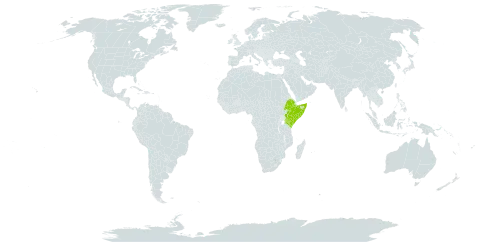Unarmed shrub or small tree up to 5 m. tall; branches stout, diverging at wide angles; bark grey, smooth or rough, often transversely folded, becoming reticulately fissured on old trunks; slash salmon-coloured, somewhat striped; exudate colourless in twigs, milky and very resinous in trunks; young twigs densely tomentose, yellowish brown, becoming blackish, slightly ridged, 2–5 mm. in diameter.. Leaves (1–)3–5(–7)-foliolate, tomentose or lanate, very densely so beneath; petiole (2–)5–27 mm. long, sometimes narrowly winged distally; rhachis of pinnate leaves narrowly winged, 7–55 mm. long; leaflets crenate-serrate, often irregularly and strongly so, bullate, the vein-network very strong and prominent beneath, its interstices sunken and filled with hairs, upper surface more even; lower lateral leaflets usually elliptic-oblong, rounded at the base, up to 20 mm. long and 14 mm. wide; the 3 apical leaflets mostly obovate and pointed at the base, the central one often attenuate basally and up to 5 cm. long and 2 cm. wide; a single irregular 2–3-lobed terminal leaflet sometimes replaces the 3 apical leaflets.. Flowers yellow, appearing with the young leaves, sessile, the ♂ flowers in fascicles up to 20, ♂ flowers single or paired; bracts triangular tomentose, up to 2 mm. long.. Calyx usually densely pubescent distally, sparsely so or subglabrous near the base, including the receptacle and 0.5 mm. long triangular lobes 2–3 mm. long.. Petals linear-elliptic, pubescent outside, 3.5–5 mm. long, 1 mm. wide.. Male flowers with 4 stamens only, filaments 3–4 mm., anthers 1–1.5 mm. long, disc pilose; ovary replaced by a tuft of hairs.. Female flowers with 4 staminodes ± 1.5 mm. long, a pubescent ovary and a 0.5 mm. style.. Fruit flattened-ovoid, sparsely pilose or glabrescent, 9–11 × 7–9 × (2.5 + 3.5) mm.; pericarp 2-valved; pseudaril with broadly triangular facial lobes, that on the sterile locule half as long as the stone, the outer shorter; sutural lobes absent; stone lumpy, broadly flattened-ovoid to cordiform, 6–7 × 6–8 × (2 + 3) mm., the sterile locule slightly humped centrally.. Fig. 8/10–15, p. 52.

